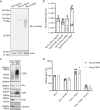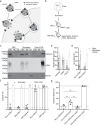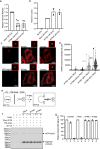Quantitative characterization of extracellular vesicle uptake and content delivery within mammalian cells
- PMID: 33767144
- PMCID: PMC7994380
- DOI: 10.1038/s41467-021-22126-y
Quantitative characterization of extracellular vesicle uptake and content delivery within mammalian cells
Abstract
Extracellular vesicles (EVs), including exosomes, are thought to mediate intercellular communication through the transfer of cargoes from donor to acceptor cells. Occurrence of EV-content delivery within acceptor cells has not been unambiguously demonstrated, let alone quantified, and remains debated. Here, we developed a cell-based assay in which EVs containing luciferase- or fluorescent-protein tagged cytosolic cargoes are loaded on unlabeled acceptor cells. Results from dose-responses, kinetics, and temperature-block experiments suggest that EV uptake is a low yield process (~1% spontaneous rate at 1 h). Further characterization of this limited EV uptake, through fractionation of membranes and cytosol, revealed cytosolic release (~30% of the uptaken EVs) in acceptor cells. This release is inhibited by bafilomycin A1 and overexpression of IFITM proteins, which prevent virus entry and fusion. Our results show that EV content release requires endosomal acidification and suggest the involvement of membrane fusion.
Conflict of interest statement
The authors declare no competing interests.
Figures





Similar articles
-
Quantitative Measurement of Extracellular Vesicle Content Delivery Within Acceptor Cells.Methods Mol Biol. 2022;2473:397-403. doi: 10.1007/978-1-0716-2209-4_25. Methods Mol Biol. 2022. PMID: 35819778
-
Content release of extracellular vesicles in a cell-free extract.FEBS Lett. 2019 Aug;593(15):1983-1992. doi: 10.1002/1873-3468.13472. Epub 2019 Jun 17. FEBS Lett. 2019. PMID: 31175663
-
Lack of involvement of CD63 and CD9 tetraspanins in the extracellular vesicle content delivery process.Commun Biol. 2023 May 17;6(1):532. doi: 10.1038/s42003-023-04911-1. Commun Biol. 2023. PMID: 37198427 Free PMC article.
-
Uptake and Fate of Extracellular Membrane Vesicles: Nucleoplasmic Reticulum-Associated Late Endosomes as a New Gate to Intercellular Communication.Cells. 2020 Aug 21;9(9):1931. doi: 10.3390/cells9091931. Cells. 2020. PMID: 32825578 Free PMC article. Review.
-
Extracellular Vesicles: Unique Intercellular Delivery Vehicles.Trends Cell Biol. 2017 Mar;27(3):172-188. doi: 10.1016/j.tcb.2016.11.003. Epub 2016 Dec 13. Trends Cell Biol. 2017. PMID: 27979573 Free PMC article. Review.
Cited by
-
3D Ex vivo tissue platforms to investigate the early phases of influenza a virus- and SARS-CoV-2-induced respiratory diseases.Emerg Microbes Infect. 2022 Dec;11(1):2160-2175. doi: 10.1080/22221751.2022.2117101. Emerg Microbes Infect. 2022. PMID: 36000328 Free PMC article.
-
TMED10 mediates the loading of neosynthesised Sonic Hedgehog in COPII vesicles for efficient secretion and signalling.Cell Mol Life Sci. 2023 Aug 25;80(9):266. doi: 10.1007/s00018-023-04918-1. Cell Mol Life Sci. 2023. PMID: 37624561 Free PMC article.
-
Loss of Christianson Syndrome Na+/H+ Exchanger 6 (NHE6) Causes Abnormal Endosome Maturation and Trafficking Underlying Lysosome Dysfunction in Neurons.J Neurosci. 2021 Nov 3;41(44):9235-9256. doi: 10.1523/JNEUROSCI.1244-20.2021. Epub 2021 Sep 15. J Neurosci. 2021. PMID: 34526390 Free PMC article.
-
Tracking the uptake of labelled host-derived extracellular vesicles by the human fungal pathogen Aspergillus fumigatus.Microlife. 2024 Nov 6;5:uqae022. doi: 10.1093/femsml/uqae022. eCollection 2024. Microlife. 2024. PMID: 39660046 Free PMC article.
-
Opportunities to accelerate extracellular vesicle research with cell-free synthetic biology.J Extracell Biol. 2023 May 18;2(5):e90. doi: 10.1002/jex2.90. eCollection 2023 May. J Extracell Biol. 2023. PMID: 38938277 Free PMC article.
References
Publication types
MeSH terms
Substances
LinkOut - more resources
Full Text Sources
Other Literature Sources
Research Materials

